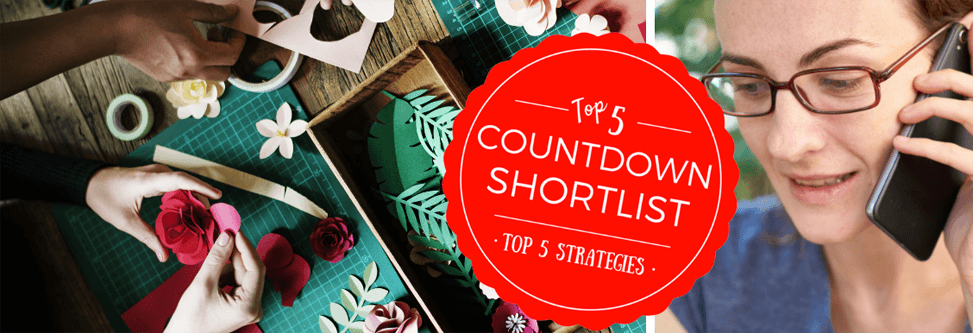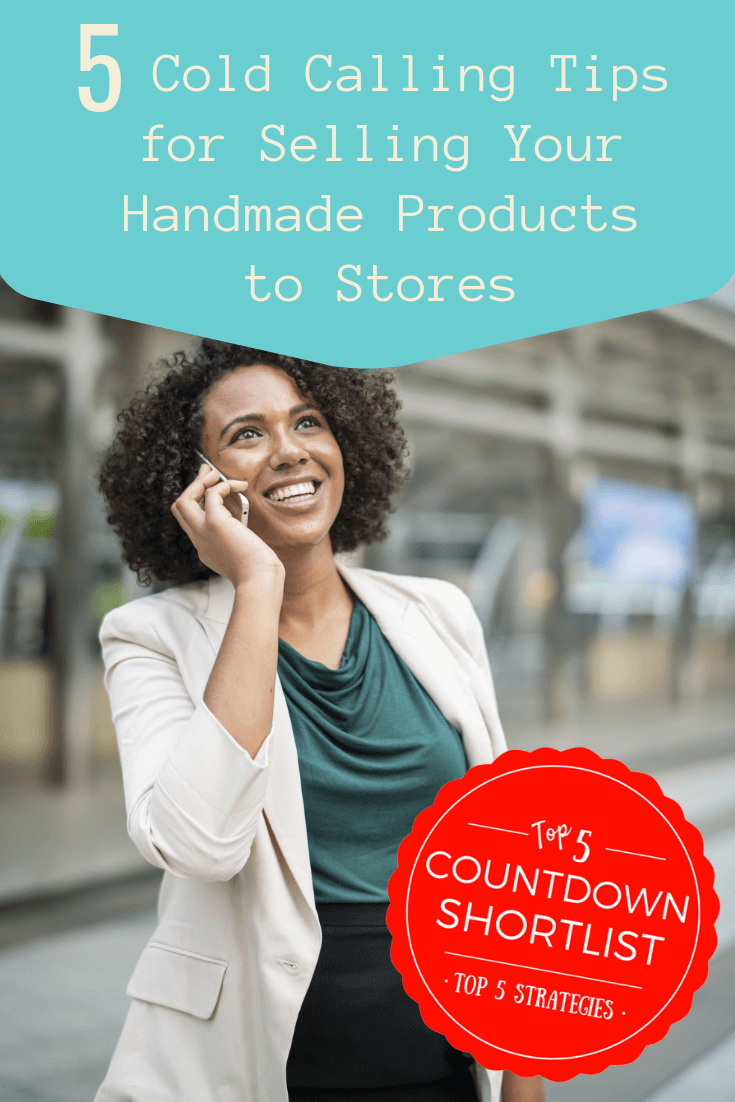5 cold calling tips
for selling your handmade
products to stores
The following five cold calling tips will help you get started selling your handmade products to stores. Often people shudder at the thought of making cold calls and prospecting does not always come naturally. Some of us are even shy and never get used to the idea, but with time, you can get in the flow of making cold calls.
5 Cold Calling Tips

#5
Follow Up - Fifth, but not least important on the cold calling tips list is follow up. This step is one that is often forgotten. It often feels easier to continue onto the next prospect than to follow through and reinitiate contact. Whether it’s because of the fear of the unknown or the worry that one will be “bothering” the store owner too much, it’s oftentimes the step that is missed.
It’s also one that could very well either land you that order or bring you closer to an order in the near future. When you send out your catalog, your website link, or your line sheets, make sure to follow up with the buyer or store owner either by email or phone.
Worried about getting on the buyer’s nerves? A simple tip is follow the lead. If the buyer seems impatient, or not as approachable as you'd like, give it a little time before you reinitiate contact, or simply ask if you can follow up in a few weeks. Follow neither fear nor impatience as both will surely impede your ability to be effective. I know we live in unpredictable times which makes the task feel that much more daunting, but remember that even in times of fluctuation, those who pursue their avenues persistently find success through perseverance.
Fear can stop you from following through and impatience can lead you to disrupting the process by pushing too hard. Outside of making a warm connection and being polite, truthfully the rest is not in your control. We all face some less desirable personalities no matter how hard we try to be professional. Short of that, it’s just a matter of understanding that you may have to hear a lot of no’s, before you get to a yes.
#4
Get Permission - Before showing up at the door of your favorite store, or even sending your line sheets to a buyer, it’s always a great idea to make contact and get permission. It’s just the respectful thing to do. Buyers and store owners are busy doing what they need to do. They are with customers, restocking merchandise, taking inventory and so on.
Calling to get permission says that you respect and understand they are busy. It says you understand the process and have a grasp on the fact that they want to choose when and who they see. Not that it’s wrong to make an introduction through email, but making a call ahead of time to get the name of the buyer and to say that you would like to show them your work, gives you a great introduction to your email.
#3
Be Genuine - While you may find a multitude of cold calling tips online, avoid using scripts that don't feel genuine. People can smell a sales pitch from a mile away, especially store owners who are in the business of buying and selling. If you're going to compliment a store owner, make it something genuine and relatable. If you love the vibe of the store back up your compliment with a real life detail. One that shows you have actually taken in the atmosphere and your words are authentic.
In some cases you might even be a customer. If you are, then you can share how much you enjoy shopping at the store. As long as you’re sharing truthfully then there's nothing wrong with using that information to make a warm connection. Otherwise, stick to clean compliments that show you have done your homework and don’t use filler statements that send the message that you will say anything to get a sale.
#2
Get the Name Right - A couple of days ago I received an sales email inviting me to attend a conference featuring Tony Robbins and Gary Vaynerchuk. Two big names in the industry, only the email opened introducing “Tony Robinson” as the speaker. Tony Robbins has been around for many, many years and he’s practically a household name. I couldn’t believe they got his name wrong!
Now, the email was just going out to prospective attendees, but none-the-less it simply looks bad. Just imagine how off-putting it would be for a store owner to receive an email addressed to the wrong name or even an incorrectly spelled name. If you expect to do business with someone then, at the very least, verify the name and the spelling.
I will never forget a letter sent to me years ago from the bank that holds my business account. It was addressed to Ms. Barnyard with the second sheet stapled on upside down. I know my last name isn’t easy to pronounce let alone spell, but really? Names are personal and if you want to do business with someone, get the name right. Getting the name right is right up there on our cold calling tips list.
#1
Do Your Homework - The first, and at the top of our cold calling tips is... do your research. Don’t even think about approaching stores until you have established whether your product is in line with the store’s vibe. I have been witness to the occasional drop-in sales call while I’ve shopped in stores and you'd be surprised the type of items salespeople bring to store owners.
Sometimes the salespeople are downright pushy and don’t have an inkling about the store and why it’s a bad fit for their products. It’s completely hit or miss. You don’t want to be that person and certainly not in the handmade market. Your collection has value and it needs to be treated as such. Do that by selecting stores that are in line with your product style, price points and brand.
A store that sells all imported items most likely won't have the appreciation for local handmade. A store with minimalist designs also may not be ideal if you sell highly detailed statement jewelry. By the same token, an 1800's historical site gift shop won't be well suited to that groovy, retro 70’s collection.
When researching stores, put yourself in the perspective of the shop’s clientele and examine what drives those customers to purchase. This will include not only style, but price points. If your collection is high-ticket, you know what to look for, but by the same token if it’s priced a little lower, it could still appeal to a slightly more upscale market as it may allow store owners to use a higher markup. These are all things you need to consider before approaching stores.
Sometimes all you can do is test the waters. Making too many assumptions about whether a store is a good fit or not can also lead you to pass up opportunities. Do your best to get a realistic feel for how well-matched a store may be, but don’t let that stop you if you're on the fence when it comes to your assessment.
Leave a comment below if you have a tip to add to the cold calling tips list : )
Return from 5 Cold Calling Tips for Selling Handmade Products to Stores to the main wholesale page

New! Comments
Have your say about what you just read! Leave me a comment in the box below.